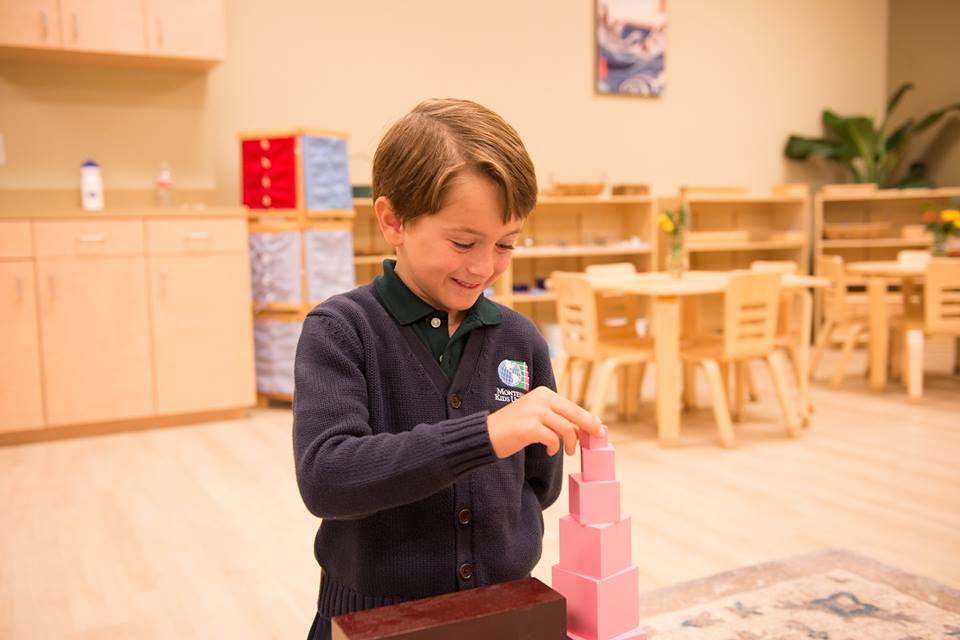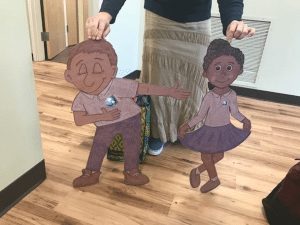Montessori School Pink Tower
The Montessori School Pink Tower is an iconic Montessori material. Deceptively simple, this set of blocks actually promotes visual discrimination and paves the way for advanced mathematical concepts.
What is the Montessori School Pink Tower?
The Pink Tower consists of ten cubic blocks in graduated sizes. The cubes range in size from one cubic centimeter to ten cubic centimeters. They are made from wood and painted uniformly in light pink.
How is the Pink Tower Used?
As with all Montessori materials, there is a specific way that children work with the Pink Tower. Their task is to stack the cubes from largest to smallest, creating a stable structure.
When the Montessori Guide first introduces this work, she demonstrates the process with minimal words to accompany her presentation. She simply shows the child what to do, and then turns the task over to him.
Students work independently with the Pink Tower. They do not need correction as they work. Montessori materials always have a control of error. A mistake will become obvious to the learner once he gets to the end of his work. If he skipped a block, it will be leftover, and he can fix it himself.
After the Pink Tower is introduced, learners are free to work with it whenever they want. They may repeat the process as many times as they please. Children will naturally repeat an activity with fervor until they have gotten what they need developmentally. When the concept has sunken in, their attention will point elsewhere.
What is the Montessori School Pink Tower’s Purpose?
The Pink Tower is part of the Sensorial Curriculum. The Sensorial Works are intended to help preschool-aged children classify the world as they take it in through their senses. At this age, they are in a sensitive period for order, and they seek out systems to organize their environment.
Within the Sensorial Works, there are materials which tune into eight different senses as defined by Maria Montessori. You may have heard of five senses, but Montessori broke down the sense of touch into four separate modes.
The Pink Tower belongs to the Visual Sensorial category. It isolates visual discrimination, bringing the child’s attention to distinguishing and ordering by size. You will notice that everything about the cubes is identical except their size. Maria Montessori designed her materials to vary in only one factor. Isolating just one determinant (in the case of the Pink Tower, size) ensures a specific purpose for each material.
The Pink Tower doesn’t just teach children about size, however. The ten cubes, graduating in size by a cubic centimeter, are the first introduction to the base-ten number system. Instead of beginning with abstract numerals, Montessori begins with a hands-on, visual representation of our number system. This prepares students to conceptually understand advanced mathematical concepts in the future, including square roots and complicated algebra.
Why is the Pink Tower Pink?
With everything you now know about the Pink Tower and its intention, you may be wondering about its iconic color. Why is it pink? Does it have to be pink? Not exactly…but also yes. How is that for an answer?
To serve its purpose, the Pink Tower does need to have some certain attributes. To isolate size as the focus, there should not be any other difference between the cubes besides their size. They should be cubes of all the same color. They should also graduate uniformly (each cube should be larger than the next by the same rate).
Technically, as long as the cubes are all the same color, they might be any color. However, Maria Montessori did not do anything randomly. She designed all of her materials extremely intentionally. She selected the color pink because it was appealing to young children. So pink is ideal when it comes to the iconic Montessori School Pink Tower. After all, it’s right there in its name!
Related: The Montessori Method and the Reggio Emilia Approach


